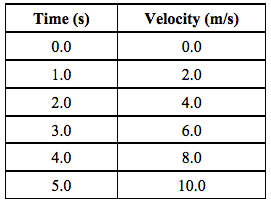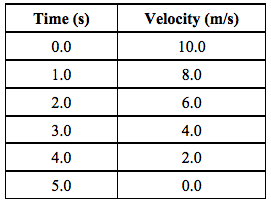When the forces acting upon an object are balanced, the object will maintain its state of motion; that is, its velocity remains constant. If the forces are unbalanced, the object will either speed up or slow down. The reverse logic is also true: if an object has a constant velocity, then the forces are balanced. And if an object is speeding up or slowing down, the forces are unbalanced.
Balanced vs. Unbalanced Forces - Questions 12 Help
There are four similar versions of this question. Two of the versions include:
Version 1:
The motion of an object is represented by velocity-time data.

Is this object speeding up, slowing down, or moving at a constant speed?
Is this object experiencing balanced forces or unbalanced forces?
Version 2:
The motion of an object is represented by velocity-time data.

Is this object speeding up, slowing down, or moving at a constant speed?
Is this object experiencing balanced forces or unbalanced forces?